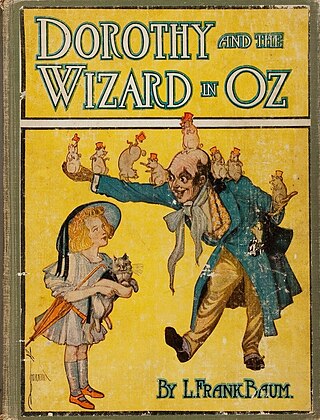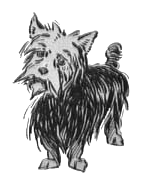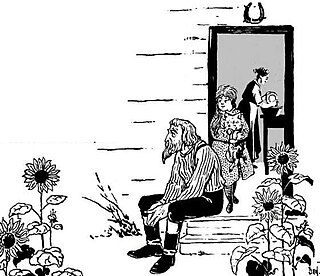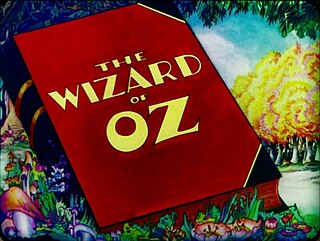
The Wonderful Wizard of Oz is a 1900 children's novel written by author L. Frank Baum and illustrated by W. W. Denslow. It is the first novel in the Oz series of books. A Kansas farm girl named Dorothy ends up in the magical Land of Oz after she and her pet dog Toto are swept away from their home by a cyclone. Upon her arrival in the magical world of Oz, she learns she cannot return home until she has destroyed the Wicked Witch of the West.

The yellow brick road is a central element in the 1900 children's novel The Wonderful Wizard of Oz by American author L. Frank Baum. The road also appears in the several sequel Oz books such as The Marvelous Land of Oz (1904) and The Patchwork Girl of Oz (1913).

Dorothy and the Wizard in Oz is the fourth book set in the Land of Oz written by L. Frank Baum and illustrated by John R. Neill. It was published on June 18, 1908 and reunites Dorothy Gale with the humbug Wizard from The Wonderful Wizard of Oz (1900). This is one of only two of the original fourteen Oz books to be illustrated with watercolor paintings. It was followed by The Road to Oz (1909).

Dorothy Gale is a fictional character created by the American author L. Frank Baum as the protagonist in many of his Oz novels. She first appears in Baum's classic 1900 children's novel The Wonderful Wizard of Oz and reappears in most of its sequels. She is also the main character in various adaptations, notably the 1939 film adaptation of the novel, The Wizard of Oz.

Oscar Zoroaster Phadrig Isaac Norman Henkle Emmannuel Ambroise Diggs, better known as the "Wizard of Oz" and, during his reign, as "Oz the Great and Terrible" or the "Great and Powerful Oz", is a fictional character in the Land of Oz created by American author L. Frank Baum. The character was further popularized by a stage play and several films, including the classic 1939 film and the 2013 prequel adaptation.

Glinda is a fictional character created by L. Frank Baum for his Oz novels. She first appears in Baum's 1900 children's classic The Wonderful Wizard of Oz, and is the most powerful sorceress in the Land of Oz, ruler of the Quadling Country South of the Emerald City, and protector of Princess Ozma.

The Land of Oz is a magical country introduced in the 1900 children's novel The Wonderful Wizard of Oz written by L. Frank Baum and illustrated by W. W. Denslow.

The Scarecrow is a character in the fictional Land of Oz created by American author L. Frank Baum and illustrator W.W. Denslow. In his first appearance, the Scarecrow reveals that he lacks a brain and desires above all else to have one. In reality, he is only two days old and merely naïve. Throughout the course of the novel, he proves to have the brains he seeks and is later recognized as "the wisest man in all of Oz," although he continues to credit the Wizard for them. He is, however, wise enough to know his own limitations and all too happy to hand the rulership of Oz to Princess Ozma and become one of her trusted advisors, though he typically spends more time having fun than advising.
The Wicked Witch of the West, a fictional character in the classic children's novel The Wonderful Wizard of Oz (1900) by the American author L. Frank Baum, is the evil ruler of the Winkie Country, the western region in the Land of Oz. She is inadvertently killed by the child Dorothy Gale. In Baum's subsequent Oz novels, the Wicked Witch of the West is referred to occasionally.

Toto is a fictional dog in L. Frank Baum's Oz series of children's books, and works derived from them. He was originally a small terrier drawn by W. W. Denslow for the first edition of The Wonderful Wizard of Oz (1900). He reappears in later Oz books and in numerous adaptations, such as The Wizard of Oz (1939) and The Wiz (1978).
Aunt Em is a fictional character from the Oz books. She is the wife of Uncle Henry and the aunt of Dorothy Gale, who lives together with them on a farm in Kansas. In The Wonderful Wizard of Oz, she is described as having been a "young, pretty wife" when she arrived at Uncle Henry's farm, but having been "grayed" by her life there, implying that she appears older than her years. Baum writes that when Dorothy came to live with her, Em would "scream and press her hand upon her heart" when startled by Dorothy's laughter, and she appears emotionally distant to her at the beginning of the story. However, after Dorothy is restored to her at the end of the book, her true nature is seen: she cries out, "My darling child!" and covers her with kisses.

The Wizard of Oz is a 1925 American silent fantasy-adventure comedy film directed by Larry Semon, who has the lead role of a Kansas farmhand disguised as the Scarecrow.

Uncle Henry is a fictional character from The Oz Books by L. Frank Baum. He is the uncle of Dorothy Gale and husband of Aunt Em, and lived with them on a farm in Kansas.

Political interpretations of The Wonderful Wizard of Oz include treatments of the modern fairy tale as an allegory or metaphor for the political, economic, and social events of America in the 1890s. Scholars have examined four quite different versions of Oz: the novel of 1900, the Broadway play of 1902, the Hollywood film of 1939, and the numerous follow-up Oz novels written after 1900 by Baum and others.

His Majesty, the Scarecrow of Oz is a 1914 American silent fantasy adventure film directed by J. Farrell MacDonald, and written and produced by L. Frank Baum. It stars Violet MacMillan, Frank Moore, Vivian Reed, Todd Wright, Pierre Couderc, Raymond Russell, and Fred Woodward.

The Wizard of Oz was a 1902 musical extravaganza based on the 1900 novel The Wonderful Wizard of Oz by L. Frank Baum. Although Baum is the credited bookwriter, Glen MacDonough was hired on as jokewriter after Baum had finished the script, and the book was largely ghostwritten by a man named Finnegan. Much of the original music was by Paul Tietjens and has been mostly lost, although it was still well-remembered and in discussion at MGM in 1939 when the classic film version of the story was made. The original show was particularly popular because of its two comedy stars: Fred Stone playing the Scarecrow, and David C. Montgomery as the Tin Woodman.

The Wizard of Oz is a 1933 Canadian-American animated short film directed by Ted Eshbaugh. The story is credited to "Col. Frank Baum." Frank Joslyn Baum, a lieutenant colonel in the United States Army and eldest son of writer L. Frank Baum, was involved in the film's production, and may have had an involvement in the film's script, which is loosely inspired by the elder Baum's 1900 novel, The Wonderful Wizard of Oz. It runs approximately eight and a half minutes and is nearly wordless, working mainly with arrangements of classical music created by Carl W. Stalling. The film is considered to potentially be the first full color animated film.

The Ozmapolitan of Oz is a 1986 novel written and illustrated by Dick Martin. The novel is an unofficial entry in the long-running Oz series written by L. Frank Baum and various successors.

The Wizard of Oz is a musical commissioned by The Muny based on the 1900 novel The Wonderful Wizard of Oz by L. Frank Baum and the 1939 film, The Wizard of Oz, using the film's songs by Harold Arlen and E. Y. Harburg. The book of the musical is by Frank Gabrielson, who would later write an adaptation of The Marvelous Land of Oz (1960) for Shirley Temple.

Dorothy of Oz is a 1989 children's novel written by L. Frank Baum's grandson Roger S. Baum. The book details Dorothy Gale returning to the Land of Oz when a Jester has been using the wand of the Wicked Witch of the West to take over the Land of Oz.






















